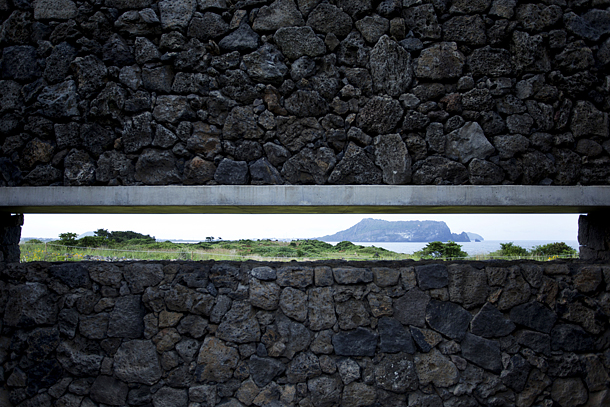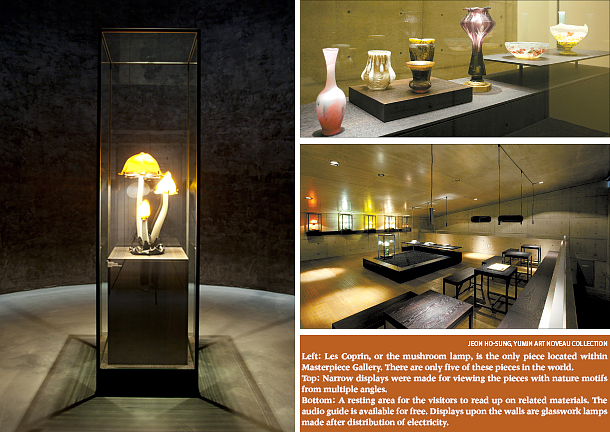Glassworks capture the subtle beauty of nature : Yumin Art Noveau’s large collection shines light on distinct art era

The outer walls of Yumin Art Noveau Collection were based on Ando Tadao’s intention to harmonize the building with Jeju Island’s landscape. Seongsan Ilchulbong is visible in the distance, running like a parallel artwork. [JEON HO-SUNG, YUMIN ART NOVEAU COLLECTION]
“Genius Loci” built by Ando Tadao nine years ago was transformed into Yumin where the backdrop of Seopjikoji Beach met the Seongsan Ilchulbong’s ridge across the ocean. Danish architect Johan Carlsson kept the characteristics of the building’s predecessor, including the structure and layout, intact.
Inside the museum, each display room has lighting optimized to bring out the best in the artwork on display. All 47 pieces inspired by nature have come from the northeastern city of Nancy in France. Each gallery contains the works of significant Art Noveau artists such as Emille Galle, the Daum brothers and other masters of glassware whose works are realistic depictions of nature created by hand.
The Masterpiece Gallery has Les Coprins, a mushroom lamp that signifies the three stages of man. The three mushroom branches symbolize youth, mid-life and old age. Galle, born in Nancy, created this centerpiece for Henry Hirsch two years before he died in 1904.
Among the five of these pieces stored across the world, Yumin Art Noveau is said to possess the best sample. Galle was a fascinating man who worked as a glass artisan, botanist, and concentrated the human spirit within Art Noveau. His glass bowl decorated with red coral was supposedly inspired by Jules Verne’s “20,000 Leagues Under the Sea.”
Inspiration Gallery is filled with works that symbolize the life force of nature. Charles Baudelaire’s “Correspondences” inspired Galle’s desire to create harmony between man and nature through reasoning and humbling oneself.
To embody the philosophy, the gallery has set up pieces inside this section at different heights to allow visitors to see the glass artworks from contrasting perspectives. “The idea came from Korea’s traditional housing having connecting themes of man and ‘floor’,” says Carlsson, “not to mention the nature of Seopjikoji’s ever transforming weather, the beautiful scenery and the horizon seen from sitting on a rock, which were all types of impressions to me.”

Between 1890 and 1910, the Art Noveau movement was prevalent in paintings, furniture pieces and glassworks all over in Europe. Compared to the mass-produced artworks of the time, the Art Noveau glasswork artisans reached masterful peaks of artistry when their handiwork and new techniques were developed in conjunction with each other, for instance.
“Parisian glass crafting was standardized as industry,” says arts scholar Ahn Ye-jin, “but the Nancy region’s works feature realism in comparison.” The technology and creativity were combined to create something that is to this day considerably unique.
BY LEE HOO-NAM [bae.seunghoon@joongang.co.kr]
Admission is 12,000 won ($10.67) for adults and 9,000 won for children. A mini shuttle ride is available in front of the lobby for free, passing through Glass House on the way and back. Regular docents are available four times a day from 10:30 a.m. to 5 p.m., but are limited to twenty people.
푸른 제주, 안도 타다오, 그리고 아르누보 유리공예
유리를 감싼 잠자리의 눈이 튀어나올 듯 입체적이고 사실적이다. 또 다른 유리작품의 잠자리는 자연이 빚어낸 기하학이라고 할만한 날개 무늬가 마치 확대경으로 보는 듯 세밀하다. 목이 긴 유리병에선 그 곡선의 흐름을 따라 난초가, 혹은 샤프란이 가지를 뻗고 자연스레 꽃잎을 벌린다. 유리그릇 겉면에 대담한 붉은 빛으로 산호를 묘사, 깊은 바다에 대한 상상을 담아낸 작품도 있다. 아름답고 화려하다. 이러한 유리공예 작품은 모두 백 년도 더 전에 프랑스에서, 그 중에도 아르누보 유리공예의 큰 부분을 차지한 북부 낭시 지역에서 만들어진 것이다.
제주도에 새로운 문화명소가 문을 열었다. 섭지코지에 새로 개관한 유민미술관은 이처럼 자연을 담은 프랑스 아르누보 유리공예 작품을, 제주의 빼어난 자연은 물론 자연과 어우러진 건축과 더불어 즐길 수 있는 곳이다. 전시장에 자리한 47점의 작품은 대부분 자연을 모티브로 삼았다. 1890년대부터 20년간 회화, 가구 디자인, 유리공예 등 다방면에서 유럽을 휩쓴 아르누보 양식의 대표적 특징이다. 여기에 다양한 기법과 장인적 솜씨를 결합, 예술적 경지에 이른 작품들이 동시대의 산업화된 유리제품과도 크게 다른 유리공예의 매력을 보여준다. 안예진 학예연구사는 “파리의 유리공예가 양식화된 반면 낭시 지역의 유리공예는 사실주의적 특징이 두드러진다”고 설명했다.
전시작의 절정은 ‘버섯 램프’다. 낭시 지역 유리공예 작가 중에 에밀 갈레의 작품이다. 갈레가 세상을 떠나기 2년 전인 1902년, 가까운 사이였던 변호사 헨리 허쉬를 위해 만든 것이다. 뛰어난 조형성은 물론 세 갈래 버섯을 통해 인생의 청년, 장년, 노년기를 함축하는 의미도 예사롭지 않다. 모두 5개가 만들어졌는데 프랑스와 일본의 미술관 등에 각각 소장돼 있다. 이 중에도 유민미술관 소장품이 가장 보존상태가 좋은 것으로 꼽힌다.
갈레는 여러모로 흥미로운 인물이다. 유리공예가에 더해 식물학 연구자였을 뿐 아니라 에밀 졸라 같은 문인과도 가까이 교류했다. 작품에는 아르누보의 정신, 나아가 당대의 인문학 정신 역시 담아내곤 했다. 붉은 산호로 심해를 묘사한 유리 그릇의 경우 쥘 베른의 ‘해저 2만리’에서 영감을 받은 것으로 전해진다. 보들레르의 시에서 받은 영감을 작품에 담기도 했다.
유민미술관은 건축 자체도 작품이다. 일본 출신의 세계적 건축가 안도 타다오의 설계로 9년 전 세워진 건축물 ‘지니어스로사이’가 국내 유일의 아르누보 유리공예 미술관으로 거듭난 것이다. 휘닉스 제주 섭지코지에 인접한 이 건축물은 주변의 자연, 바다 건너 보이는 성산일출봉의 능선과 어우러지는 것으로 널리 알려져 있다. 새로 미술관 전시 디자인을 맡은 덴마크 건축가 요한 칼슨은 안도 타다오의 건축이 지닌 특징을 존중했다. 각 전시실도 기존의 공간 구획을 따라 구성했다. 전시실마다 작품에 최적인 조명과 여러 방향에 관람이 가능한 배치를 곁들여 아르누보 유리공예의 매력을 쉽게 느낄 수 있게 했다.
그 중 ‘영감의 방’으로 이름 붙은 전시실은 한쪽은 의자 높이에 앉아, 다른 쪽은 우리네 좌식생활의 습관대로 바닥에 얕게 설치한 자리에 앉아 각각 관람할 수 있도록 했다. 칼슨은 “한국의 전통가옥에서 사람과 ‘바닥’의 연관성에 큰 영감을 얻었다”고 밝혔다. 그는 또 특히 섭지코지의 자연에 대해 “변화무쌍한 날씨와 아름다운 풍경, 그리고 바위에 앉아 바다의 수평선을 바라 볼 수 있다는 사실에 매우 감명받았다”고 전했다.
칼슨은 미술관 입구 안팎에 거울의 효과를 지닌 색유리 ‘샤이닝 글라스’를 새로 설치, 자연을 담아내는 또 다른 프레임을 더했다. 미술관 외벽에 가늘고 길게 설치한 색유리는 보는 각도에 따라 초원과 능선, 하늘과 바다를 번갈아 담아낸다. 관람객이 미술관 건물에 시선을 주면서도 주변의 자연을 움직이는 액자를 통해 보는 듯한 효과다. 입구 안쪽 벽면의 색유리는 수련이 피어있는 정원의 자연이 마치 두 배의 넓이로 펼쳐지는 듯한 시각적 체험을 안겨준다. 유민미술관 관람료는 성인 기준 1만 2000원. 개관기념으로 7월 21일까지 1만원.
이후남 기자










with the Korea JoongAng Daily
To write comments, please log in to one of the accounts.
Standards Board Policy (0/250자)